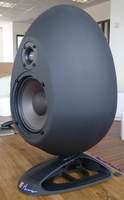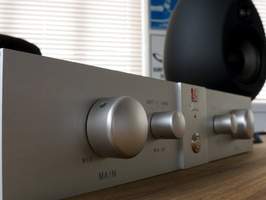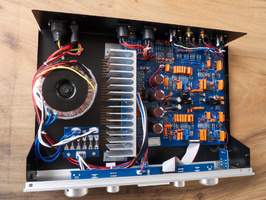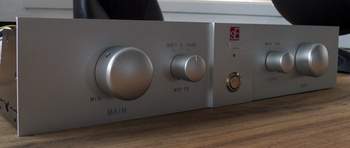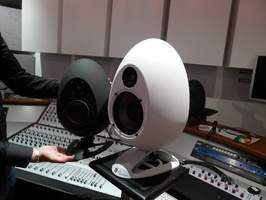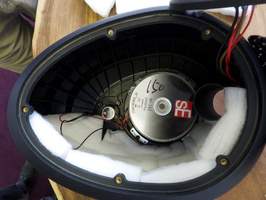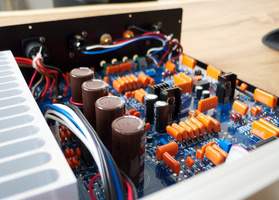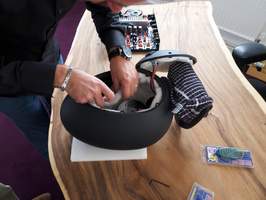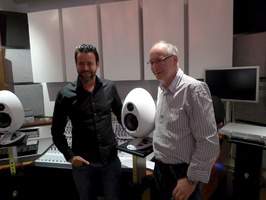sE Electronics is a Chinese-British company that was founded over 10 years ago to compete in the microphone market. Now sE Electronics has decided to enter the studio monitor market. In order to break into this market segment, the manufacturer went all the way and asked Andy Munro, a famous designer, to give an original look to its brand-new product. Egg laying has begun!
The introduction of the Egg is a big challenge for sE Eletronics, considering that entering a new market is never an easy process. That’s why sE Electronics wanted to have a famous name on board. They met Andy Munro from Munro Acoustics who has had many well-known recording studios (Air Studios, Sphere Studios, Metropolis) and several famous artists (Massive Attack, U2, Coldplay) as his clients. He also collaborated with Dynaudio, so it is not his first attempt at this! In the past, sE Electronics already cooperated with Rupert Neve, another big name in the audio industry, to launch high-grade microphones (RNR1 and RN17). So it is not a first attempt for sE Electronics either!
London Hen
| Also available in white finish, other colors coming soon. |
The first step of this review took place in Hitchin (less than 30 minutes from London) at Sonic Distribution’s office, the headquarters of Ishmaev-Young and Phil Smith who have been sE Electronics’ partners in the UK since 2002. There, we had the chance to meet the agreeable Andy Munro to talk about his new babies. Of course, it was also the opportunity for us to listen to the Egg 150 in the studio built in Sonic Distribution’s basement.
Andy Munro explained to us everything, starting with the very original shape of the speakers. Even if its original design is a plus with regard to marketing and sales — the Egg is definitely an eye-catcher in the studio monitor market segment— there are, first and foremost, acoustical reasons to it. The manufacturer asserts that this shape reduces diffraction interferences and smooths the frequency response curve, while reducing the size of the speaker and lowering the crossover frequency to avoid phase shift. Of course, the goal of this development was to get the most linear frequency response curve and a smooth energy diffusion within a room. Munro asserts that the ovoid shape is the second best solution after the wall-recessed speaker installation you can see in high-end recording studios. By the way, do notice that the transducers are mounted on a flat surface instead of being part of the egg shape itself.
For the shell construction, Munro chose a rather thin but very rigid plastic material in order to reduce resonances. That way, the resonance frequency is way above the woofer and the crossover frequency. And since the tweeter is mounted in a sealed volume, there is no resonance frequency problems anymore. As for the electronics, the designer made very clear choices. He designed a fully analog system using neither DSP nor digital processing.
If you want more information, watch the full video presentation with Andy Munro here:
We had a very good impression when we heard the Egg for the first time in Sonic Distribution’s studio (very good acoustic treatment by the way). A well-balanced frequency response and a tight and precise bass reproduction (although we had no other monitor for comparison). However, before giving our opinion about it, we wanted to wait until we received the Egg two weeks later so that we could compare it with another well-known 6" studio monitor: Focal’s Solo6 Be.
But first of all, let’s have a look at the Egg.
What’s New?
sE Electronics and Andy Munro don’t usually do things like normal people do: the Egg has the distinct feature of being sold only in pairs and with an external 19"-rack amplifier. The bulky cardboard box includes three different boxes for the two speakers and the external amplifier. The first surprise is that both speakers are marked and each is assigned either to the right or the left channel. In fact, sE Electronics calibrates the speakers and builds matched pairs before sending them to the user! A very good initiative! Another professional and very welcomed feature is that you get a zero downtime three-year warranty. This means that if a speaker breaks, it will be immediately replaced by another one while it is repaired. Thus, you will be able to keep on working without a problem. Sweet!
The external amplifier is built in a 2U 19" rack. But it doesn’t mean that we have a passive system. The difference between passive and active systems is the position of the crossover in the signal path. Explanation: most studio monitor speakers use two or three transducers, that’s why they are called two-way or three-way systems. Each transducer reproduces a given frequency range (the tweeter is in charge of the high frequencies and the woofer of the mid/low frequencies), so the full-range signal must be filtered before it reaches the transducers. This is the job of the crossover (the crossover frequency is set at 2.1 kHz for the Egg). And the crossover can be placed before or after the amplification stage. If it is before, you’ll have to use two different amps (bi-amping) for each two-way speaker — and it is considered an active system. When the crossover is placed before the amplifier on the signal path the system will use only one amp — and it is considered a passive system. The advantage of an active system is that you can use the most adequate amp for each speaker (output power, impedance…) to make the best out of each transducer. The Eggs are connected to the amplifier via a large three-meter cable with four-pin Speakon connectors. We have two wires per monitor speaker, so the system is active! The external rack includes four amp stages (50 watts RMS each) and two power supplies.
Having an external amp section has its pros and cons. If you already have a rack, you’ll find it very convenient to have the possibility to access the volume control of your speakers and the power switch directly. On the other hand, if you have a small home studio without a rack, the external amp will take a lot of space. The rear panel of the amplifier features four inputs: a pair of XLR connectors (+4 dBu or –10 dBV) and a pair of RCA connectors (-10 dBV). You can connect the output of your mixer or your sound card to the XLR inputs while your CD player or iPod can feed the RCA connectors. This way, you can switch between both signal sources quickly and easily using the front selector. Since each input pair has its own volume control, comparing your new mix with your favorite/reference recordings is very easy. Moreover, you don’t need to power on your DAW when you only want to listen to a song. Last but not least, the rear panel of the external amp offers two trim pots to adjust the high and low frequency ranges with a screwdriver. Turning the HF Trim 45 degrees counterclockwise leads to a 1dB cut at 10 kHz (shelving filter). The LF Trim allows you to attenuate the low-frequency level up to 10dB below 63 Hz.
Besides the two big volume controls that feel very pleasant, the front panel also features a source selector (AUX or Main), a headphones out that mutes the speakers when used (nice!), and a mid-frequency control. The latter gives you the possibility to boost/cut the signal up to 1.5dB at 2 kHz to get a more typical hi-fi sound with a slightly more contoured frequency response, allowing for a more pleasant listening experience (very handy when you have clients in your studio!). On the other hand, it also allows you to slightly boost the mid range when you want better control over some details in your mix (vocals for instance). The designers of the Egg call this control the “NS-10 shift, ” after Yamaha’s famous studio monitor that had the ability to point out some details in the mix due to its very typical frequency response. We find this idea very clever and practical! Generally, we miss such features on more affordable studio monitors that have the bad habit of masking the mid range behind over-emphasized low and high frequency responses.
| 4" version coming soon. |
To close this overall description, let us note that the surface of the shell feels soft to the touch (like rubber) but seems susceptible to scratches. Above the tweeter, a blue LED helps you to find the best position for your monitor speakers. You are on axis with regard to the speaker when the LED is brighter, which is a very practical detail when setting them up. However, you can disable the LEDs using a switch on the rear panel of the amplifier. Also notice that the speaker is front-ported, and that the bass reflex port is under the woofer. Inside the egg, you’ll find a pair of transducers: a 6.5" polypropylene cone woofer (50 watts RMS) and a 1" silk dome tweeter. The integrated base allows the speaker to stand upright or to be slightly tilted forward.
Now, let’s give them a try!
Comparative Review
To test the Egg, we listened to high-quality productions including a lot of sound details, which we know extremely well. We placed both speaker pairs (Focal Solo 6Be and sE Electronics Egg) on speaker stands and fed them with the output signal of our Mbox Pro. This audio interface allows you to quickly switch between two speaker pairs, which is essential for a comparative review. We first started with the factory settings and then changed them to assess their behavior. Here is our listening report:
| sE Electronics speaker |
Johnny Cash – Hurt
Let’s start with Johnny Cash’s song “Hurt, ” written by Trent Reznor from Nine Inch Nails for the “American IV: The Man Comes Around” album. This album includes a wide range of covers and was recorded by Rick Rubin. The song consists of two movements that get louder and emphasize Cash’s Martin acoustic guitar and voice.
With the Focal speakers, Cash’s voice is more present because the mid range is a little bit more emphasized. The voice sound more nasal than with the Eggs but cuts better through the mix. The same applies to the attacks of the acoustic guitar that are stronger with the Solo6. Generally speaking, the signal seems to be closer with the Solo6 while the Egg give more air to the sound (high frequencies). We tried to compare both speakers enabling the “Hard” (1.5-dB boost @ 2 kHz) on the Eggs: the differences in the high-mid range clearly decrease. However, the Eggs still had more air, so we decided to adjust the settings on the amp rear panel. As described in the user’s manual, for monitoring applications, it is recommended to attenuate the high-frequency range (last octave) by 2 dB (about a quarter of a turn). Afterwards, the differences became very minimal and it became difficult to decide between both speakers. We heard differences in the spectral image but both monitors reproduce the song very faithfully and their tonal balance is quite similar. However, it is interesting to point out that the controls provided by the Eggs are very effective and allow you to switch between typical hi-fi reproduction (contoured response, more highs) and a more analytical monitoring.
Let’s move on to the next song.
Massive Attack – Angel
Now it’s the turn of Massive Attack’s “Angel, ” with its powerful low and ultra-low frequencies: a real crash test!
First of all, let’s focus on the rimshot and the hi-hat: they are identical with the two speaker pairs. The bass drum has less low-end but more punch with the Focal monitors. With the Eggs, the bass guitar sounds a bit softer and has less attack. Generally speaking, sE Electronics’ speaker can reproduce lower frequencies than the Solo6 but loses a bit on dynamics. We used this song to adjust the low-frequency response on the amplifier so that it matches that of the Focal: one quarter of a turn was enough. That way, both speakers can compete on the same basis and none of them could really beat the other.
The Raconteurs – Consolers of the Lonely
We especially like this song recorded by Jack White’s band because it combines the power of modern productions with a vintage sound color. Fat rock, just the way we like it! And the mix is fully packed with small details.
Without changing the amp settings, the former observations still apply: the frequency response of the Eggs reaches higher and lower and seems to be more contoured than the Focal. As a consequence, vocals have more punch with the Solo6 and backing vocals cut better though. The overall sound seems more compact. With the Eggs, the bass booms a bit more.
On the other hand, switching the Eggs into Hard mode while attenuating the high and low ends as we did before, it becomes much more difficult to decide between the Focal and sE Electronics when it comes to sound balance. Both monitors seem quite transparent and the slight differences perceived will have almost no impact on your work. However, the Focal have a slightly more analytical response and, thus, are more tiring.
Michael Jackson – Liberian Girl
Here comes a softer Micheal Jackson song. Taken from the album Bad produced by Quincy Jones. The sound is still a reference, even if it is evidently from the 80's.
The bass drum and the vocals are more contoured with the Eggs (less low-mids) while the voice has more presence with the Focal. The instruments seems to sound a bit further back with the sE Electronics because of the emphasized high frequencies and the slightly attenuated mid-range. The pads have more air than with the Solo6, which has a tighter and more compact sound. In Hard mode, the differences between both speakers decrease once again and vocals are almost identical.
Metallica – Enter Sandman
Let’s carry on with another reference song taken from Metallica’s '91 Black Album. The fills played on the toms come to show once again that the Eggs reach lower frequencies (without low-frequency filtering) than the Solo6 but that the overall response is more contoured than with the Focal. Once again, the Eggs provide more air and the music seems to go further back. Of course, cymbals are more present with the high-frequency default setting on the rear panel of the amp. In Hard mode, vocals and guitars cut better through the mix and the sound comes close to the Focal. Like with the previous recordings, attenuating high and low frequencies a bit allows you to get a more typical response for monitoring applications, closer also to the Solo6. Although both speakers keep their own personality, all mixes are coherent and the sound balance is always the same.
Miles Davis – Seven Steps to Heaven
Miles introduces you to jazz music. On this song, it is very difficult to decide between the two speakers. However, the ride cymbal cuts better through and is brighter with the Eggs, which still gives more air than the Focal. With the latter, the trumpet cuts slightly better through. Anyway, both speakers give very good results. Both have a wide dynamic range and the stereo image is perfect. The sound is very articulated and it’s a real delight to listen to this song with both speakers. Playing with the settings we were able to reduce the differences between both monitors to a mere anecdote.
So it’s time to draw conclusions…
Conclusion
The Eggs need not be ashamed in front of the Focal Solo6 Be. In fact, these speakers signed by sE Electronics and Munro prove to be very versatile thanks to the controls on the external amplifier. They allow you to get a typical hi-fi sound reproduction when you want to listen to music for yourself or show your work to your clients, but also a Focal-like analytic monitoring (by boosting mids and attenuating the high and low ends). It’s obvious and it’s no secret that sE Electronics aims for two different markets (hi-fi and pro audio). Anyway, this versatility is a priceless advantage for home-studio owners who want to use their monitor speakers for purposes other than studio work.
sE Electronics has bet on originality (both at the concept and design levels) and it could prove really profitable. With its acceptable price and new 4" and 8" versions coming soon, the new studio monitor range signed by sE Electronics and Munro seems to have a bright future ahead.


